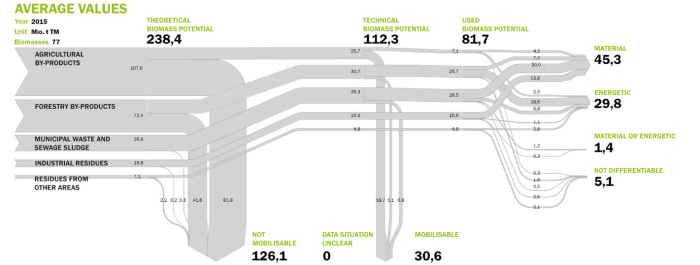Potentials studies on residues and waste materials, Status Quo
In the previous chapters you have learned that biomass is suitable as a raw material for various energy conversion paths and can therefore make an important contribution towards the renewable energy system. At the same time, biogenic residues, by-products and waste are to be used as completely and efficiently as possible in the targeted circular economy. It is therefore not surprising that different studies are considering the question what quantities of biogenic resources are available for energy use today and in the future. The differences between these studies are sometimes very significant (cf. Creutzig et al. 2015). This is partly due to the fact that so far there is no standardised method for the calculation of biomass potentials and that therefore deviations due to the non-uniform use of term allocations, conversion factors, data sources, restrictions, etc. exist.
In the field of biogenic residues and wastes, the DBFZ-Resource Database provides data and evaluations of 77 individual biomasses from five sectors as open data. The data sets and extensive accompanying materials, such as flowcharts and Sankey diagrams, can be downloaded online and used further. The DBFZ-Resource Database can also be used to determine the contribution that selected biomasses could make to sub-sectors of the energy system. The results of the study show that on average 30.6 million tDM can be mobilised. Search the DBFZ resource database to find out what contribution this amount could make to sub-areas of the energy system! The largest biomass potentials that can still be mobilised are forestry by-products and agricultural by-products (see Sankey diagram below). In addition, additional potentials can be tapped by optimising existing utilisation paths (e.g. cascade utilisation).
Biomass residue potentials and their current utilisation (in German). Source: Brosowski et al. 2019
Brosowski, André; Krause, Tim; Mantau, Udo; Mahro, Bernd; Noke, Anja; Richter, Felix; et al. (2019): How to measure the impact of biogenic residues, wastes and by-products: Development of a national resource monitoring based on the example of Germany. In: Biomass and Bioenergy, Volume 127 (2019). Online verfügbar unter: https://www.sciencedirect.com/science/article/pii/S0961953419302247
DBFZ-Resource Database: webapp.dbfz.de
Fachagentur für Nachwachsende Rohstoffe (FNR, in German): Basic Data on Renewable Resources
